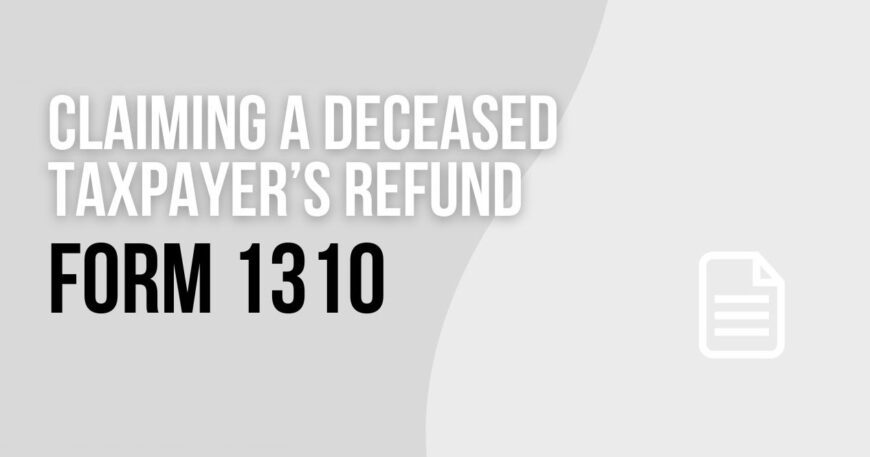Understanding IRS Form 1310 and How Syed Professional Services Can Help You
When a taxpayer passes away, their tax obligations don’t necessarily end. When the deceased owes a refund, IRS Form 1310 is crucial in ensuring the correct refund issuance. Navigating the complexities of tax forms and IRS procedures can be daunting, especially during such a sensitive time. Fortunately, Syed Professional Services offers expert assistance in completing Form 1310 and other related tax matters.
What is IRS Form 1310?
When someone needs to claim a refund on behalf of a deceased taxpayer, they typically use IRS Form 1310, also known as the Statement of a Person Claiming Refund Due a Deceased Taxpayer. Typically, the estate or deceased’s representative will use this form to assert their right to a refund. The form ensures that the IRS issues any refunds to the right person or entity due to the decedent.
If you need help filing Form 1310 or have questions about how it applies to your situation, Syed Professional Services is here to help.
Why Would You Need to File IRS Form 1310?
If you’re wondering why Form 1310 is necessary, it’s essential to understand that the IRS generally doesn’t issue refunds directly to a deceased taxpayer’s estate or personal representative without proper documentation. The form serves as a protective measure, assisting the IRS in verifying the claim’s validity and guaranteeing the correct recipient receives the refund.
Here are some common reasons why you might need to file IRS Form 1310:
- Claiming a Refund: The most common reason for filing Form 1310 is when a deceased taxpayer is due a refund. The personal representative or executor of the estate may claim a rebate on behalf of the decedent.
- If no appointed executor or administrator is appointed, the IRS may require the claimant to complete Form 1310 to ensure proper refund handling.
- Claims Made by a Survivor: If you’re a surviving spouse or close relative entitled to the refund, you may also need to file the form, significantly if the refund amount exceeds a certain threshold.
Filing IRS Form 1310 is crucial to ensuring that the rightful recipient receives the refund due to the deceased taxpayer.
Who Can File Form 1310?
While a variety of people can file IRS Form 1310, it’s essential to consider specific requirements. Generally, it can be filed by: If eligible for the refund, the
- e surviving spouse can file Form 1310 and the deceased’s final tax returd.
- The personal representative or executor: If the deceased has an appointed executor or personal representative, they can file the form to claim tax refunds.
- A family member: In some situations, a close relative or person with the legal right to claim the refund can file the form, provided they meet the IRS’s requirements.
The decedent often files Form 1310 alongside their final tax return, typically Form 1040. It is essential to follow all the required steps carefully to avoid confusion or delays.
Step-by-Step Guide to IRS Form 1310 Instructions
Navigating Form 1310 can be tricky without proper guidance. Below is a simplified overview of the steps and instructions to help you through the process.
- Gather Required Documentation: Before you begin filling out Form 1310, ensure you have all necessary documents. These may include the deceased taxpayer’s death certificate, a copy of the final tax return, and proof of your relationship to the deceased (for family members or non-executors).
- Complete the Basic Information: Provide basic details about the decedent, including their name, Social Security Number (SSN), and the filing year for which you claim the refund in Part I of Form 1310.
- Please provide information about the claimant: In Part II, the person filing the claim (the claimant) must provide their own identifying information, including their name, address, and relationship to the deceased. This form ensures that the IRS knows who claims the refund and why.
- Sign and Date: The claimant must sign the form, verifying that the information provided is correct and that they have the legal right to make the claim.
- Attach the Necessary Documents: If you are claiming a refund on behalf of the deceased, you may need to attach papers such as the death certificate, proof of your relationship to the decedent, or a copy of the decedent’s will or trust. This step is critical to ensuring that the IRS can verify the legitimacy of your claim.
Common Mistakes to Avoid When Filing Form 1310
While filing IRS Form 1310 may appear simple, many people make common mistakes that can cause delays or prevent the processing of their claims. Here are a few to watch out for:
- Failure to Include All Required Documentation: One of the most frequent errors is not submitting all the required documents. Ensure you have the death certificate, proof of relationship, and any relevant supporting documents attached to your Form 1310.
- Errors in the decedent’s personal information, such as the SSN or the claimant’s information, can lead to a rejection of your claim. Double-check all entries for accuracy before submission.
- Failure to Sign the Form: Many individuals forget to sign Form 1310. Remember, this is a legal document; without your signature, the IRS will not process it.
If you’re unsure about any aspect of the form or need guidance through the process, Syed Professional Services is here to help you avoid these pitfalls.
How Syed Professional Services Can Help You with IRS Form 1310
Navigating the complexities of tax laws, especially when dealing with the passing of a loved one, can be overwhelming. That’s where Syed Professional Services comes in. Our team of experienced tax professionals is well-versed in IRS procedures. It can help you with every process step, from understanding the requirements to submitting the necessary forms.
Here’s how we can assist you with Form 1310:
- Expert Guidance: We can walk you through completing Form 1310, ensuring all information is accurate and compliant with IRS requirements.
- Documentation Assistance: We’ll help you compile and arrange the necessary paperwork to prevent errors and delays in processing your claim.
- Filing Support: After reviewing and completing your Form 1310, we’ll assist you in filing it with the IRS and answer any questions.
- Peace of Mind: Dealing with taxes after a loved one’s death can be emotional and stressful. Let Syed Professional Services take the burden off your shoulders so you can focus on what truly matters.
Frequently Asked Questions About IRS Form 1310
What happens if I don’t file IRS Form 1310?
If you don’t file Form 1310 when claiming a refund on behalf of a deceased taxpayer, the IRS will not process the refund. The form is essential to guarantee the rightful claimant receives the refund.
Do I need to file Form 1310 for every deceased taxpayer?
No. You only need to file Form 1310 if you claim a refund for a deceased taxpayer. You do not need to file the form if no refunds are due.
Can a surviving spouse file IRS Form 1310?
Yes. If the surviving spouse is eligible to claim a refund on behalf of the deceased spouse, they can file Form 1310. The spouse can often file the form with the final tax return.
How long does it take for the IRS to process Form 1310?
Processing times can vary, but typically, the IRS takes 6 to 12 weeks to process Form 1310 and issue refunds.
What if the decedent didn’t file a tax return?
If the deceased did not file a tax return for the year they passed, the personal representative may need to file a final return for them before filing Form 1310.
Can I file Form 1310 if I am not the estate executor?
Yes, you can file Form 1310 if you are the surviving spouse or another family member eligible for the refund. You will need to provide documentation proving your relationship to the deceased.
Conclusion
Filing IRS Form 1310 is a necessary step in claiming refunds on behalf of a deceased taxpayer. Correct completion of the form is crucial for receiving any owed refunds, regardless of whether you are the surviving spouse, family member, or the appointed representative of the deceased. At Syed Professional Services, we specialize in helping you navigate the tax complexities surrounding the death of a loved one. Our team handles everything smoothly and efficiently, from completing the form to submitting the necessary documentation.
If you need help with IRS Form 1310, don’t hesitate to contact Syed Professional Services. We are here to support you every step of the way.



